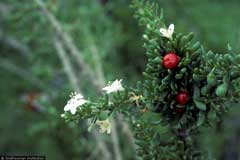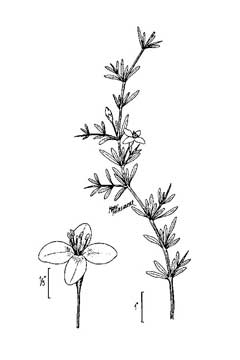 |
|
R.A. Howard @ USDA-NRCS PLANTS Database |
 |
| USDA-NRCS PLANTS Database / USDA NRCS. Wetland flora: Field office illustrated guide to plant species. USDA Natural Resources Conservation Service. |
Translate this page:
Summary
Physical Characteristics

 Lycium carolinianum is an evergreen Shrub growing to 1.5 m (5ft).
Lycium carolinianum is an evergreen Shrub growing to 1.5 m (5ft).
See above for USDA hardiness. It is hardy to UK zone 8. It is in leaf all year. The species is hermaphrodite (has both male and female organs) and is pollinated by Bees.
Suitable for: light (sandy), medium (loamy) and heavy (clay) soils, prefers well-drained soil and can grow in nutritionally poor soil. Suitable pH: mildly acid, neutral and basic (mildly alkaline) soils. It cannot grow in the shade. It prefers moist soil. The plant can tolerate maritime exposure.
UK Hardiness Map
US Hardiness Map
Synonyms
Plant Habitats
Woodland Garden Sunny Edge;
Edible Uses
Edible Parts: Fruit
Edible Uses:
Fruit - raw or cooked. Rather pleasant eating, the fruit has a slightly salty taste[183]. The fruit is a berry up to 12mm in diameter[200]. Only the fully ripe fruits should be eaten[K].
References More on Edible Uses
Medicinal Uses
Plants For A Future can not take any responsibility for any adverse effects from the use of plants. Always seek advice from a professional before using a plant medicinally.
Cancer
The fruit of many members of this genus is a very rich source of vitamins and minerals, especially in vitamins A, C and E, flavanoids and other bio-active compounds. It is also a fairly good source of essential fatty acids, which is fairly unusual for a fruit. It is being investigated as a food that is capable of reducing the incidence of cancer and also as a means of halting or reversing the growth of cancers[214].
References More on Medicinal Uses
The Bookshop: Edible Plant Books
Our Latest books on Perennial Plants For Food Forests and Permaculture Gardens in paperback or digital formats.

Edible Tropical Plants
Food Forest Plants for Hotter Conditions: 250+ Plants For Tropical Food Forests & Permaculture Gardens.
More

Edible Temperate Plants
Plants for Your Food Forest: 500 Plants for Temperate Food Forests & Permaculture Gardens.
More

More Books
PFAF have eight books available in paperback and digital formats. Browse the shop for more information.
Shop Now
Other Uses
Soil stabilization
Plants have an extensive root system and can be planted to stabilize banks[200].
Special Uses
References More on Other Uses
Cultivation details
An easily grown plant, succeeding in most soils[11]. It does not require a rich soil, flowering and fruiting better in a well-drained soil of moderate quality[11]. Succeeds in impoverished soils[200]. Requires a sunny position[200]. Tolerates maritime exposure[200]. This species is not very hardy outside the milder areas of Britain, it tolerates temperatures down to between -5 and -10°c[200].
References Carbon Farming Information and Carbon Sequestration Information
Temperature Converter
Type a value in the Celsius field to convert the value to Fahrenheit:
Fahrenheit:
The PFAF Bookshop
Plants For A Future have a number of books available in paperback and digital form. Book titles include Edible Plants, Edible Perennials, Edible Trees,Edible Shrubs, Woodland Gardening, and Temperate Food Forest Plants. Our new book is Food Forest Plants For Hotter Conditions (Tropical and Sub-Tropical).
Shop Now
Plant Propagation
Seed - sow early spring in a greenhouse. Germination is usually good and fairly quick. Prick out the seedlings into individual pots when they are large enough to handle and grow them on in the greenhouse for their first winter. Plant out in late spring or early summer. Pinch out the shoot tips of the young plants in order to encourage bushy growth[78]. Cuttings of half-ripe wood, 5 - 10cm with a heel if possible, July/August in individual pots in a frame. Good percentage[78]. Cuttings of mature wood of the current season's growth, autumn to late winter in a cold frame. High percentage[78, 200]. Division of suckers in late winter. Very easy, the suckers can be planted out direct into their permanent positions. Layering.
Other Names
If available other names are mentioned here
Native Range
NORTHERN AMERICA: United States (Florida, Georgia, Texas)
Weed Potential
Right plant wrong place. We are currently updating this section.
Please note that a plant may be invasive in one area but may not in your area so it's worth checking.
Conservation Status
IUCN Red List of Threatened Plants Status :

| Related Plants
|
| Latin Name | Common Name | Habit | Height | Hardiness | Growth | Soil | Shade | Moisture | Edible | Medicinal | Other |
| Berberis lycium | | Shrub | 3.0 |
5-9
| M | LMH | SN | DM | 3 | 3 | 1 |
| Lycium afrum | | Shrub | 2.0 |
8-11
| | LMH | N | DM | 1 | 2 | 3 |
| Lycium andersonii | Wolfberry, Water jacket | Shrub | 0.0 |
0-0
| M | LMH | N | DM | 1 | 2 | 3 |
| Lycium arabicum | | Shrub | 0.0 |
-
| | LMH | N | M | 1 | 2 | 2 |
| Lycium australe | | Shrub | 1.0 |
-
| | LMH | N | DM | 1 | 2 | 2 |
| Lycium barbarum | Goji, Box Thorn, Matrimony vine | Shrub | 2.5 |
6-9
| M | LMH | SN | M | 4 | 3 | 3 |
| Lycium berlandieri | Berlandier's wolfberry | Shrub | 0.0 |
0-0
| | LMH | N | DM | 1 | 2 | 2 |
| Lycium chinense | Chinese Boxthorn, Chinese desert-thorn | Shrub | 2.5 |
5-9
| M | LMH | N | M | 4 | 3 | 3 |
| Lycium europaeum | European tea-tree, Box thorn, | Shrub | 4.0 |
8-11
| M | LMH | N | M | 3 | 2 | 3 |
| Lycium ferocissimum | African Boxthorn | Shrub | 3.0 |
8-11
| M | LMH | N | DM | 0 | 0 | 2 |
| Lycium fremontii | Desert Thorn, Fremont's desert-thorn | Shrub | 3.0 |
0-0
| | LMH | N | DM | 1 | 2 | 2 |
| Lycium pallidum | Pale Wolfberry, Pale desert-thorn, Rabbit thorn | Shrub | 1.8 |
5-9
| | LMH | N | DM | 3 | 2 | 3 |
| Lycium ruthenicum | | Shrub | 2.0 |
5-9
| | LMH | N | DM | 3 | 2 | 3 |
| Lycium schweinfurthii | | Shrub | 2.0 |
-
| | LMH | N | DM | 2 | 2 | 2 |
| Lycium torreyi | Squawthorn, Torrey wolfberry | Shrub | 3.0 |
0-0
| | LMH | N | DM | 2 | 2 | 2 |
|
Growth: S = slow M = medium F = fast. Soil: L = light (sandy) M = medium H = heavy (clay). pH: A = acid N = neutral B = basic (alkaline). Shade: F = full shade S = semi-shade N = no shade. Moisture: D = dry M = Moist We = wet Wa = water.
Now available:
Food Forest Plants for Mediterranean Conditions
350+ Perennial Plants For Mediterranean and Drier Food Forests and Permaculture Gardens.
[Paperback and eBook]
This is the third in Plants For A Future's series of plant guides for food forests tailored to
specific climate zones. Following volumes on temperate and tropical ecosystems, this book focuses
on species suited to Mediterranean conditions—regions with hot, dry summers and cool, wet winters,
often facing the added challenge of climate change.
Read More
Expert comment
Author
Walter.
Botanical References
200
Links / References
For a list of references used on this page please go here
Readers comment
© 2010, Plants For A Future. Plants For A Future is a charitable company limited by guarantee, registered in England and Wales. Charity No. 1057719, Company No. 3204567.